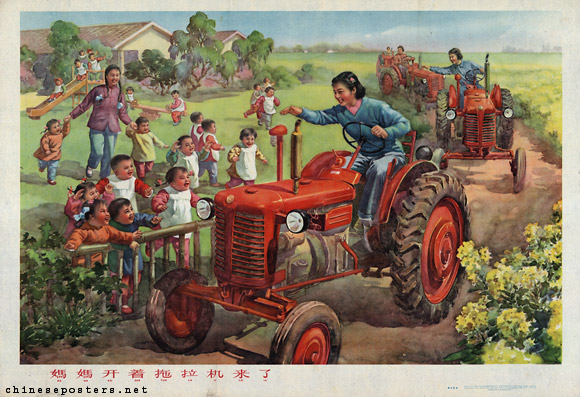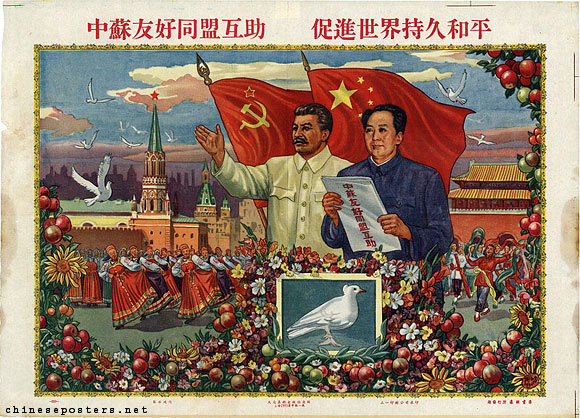The 1949 Soviet film “Cossacks of the Kuban” was an instant success both in the Soviet Union and in the newly founded People’s Republic of China. The film’s popularity was a result of Sino-Soviet cooperation and waned just when relations between the states deteriorated. Today, the film is largely forgotten in China, but its songs are still sung.
Old Filmmakers – „New China“
Republican-era Shanghai, known for its ballrooms, music halls, and cinemas, had served as the centre of Chinese film production and consumption throughout the 1920s and 30s. While China had a functioning domestic film industry at that time, the majority of films screened in urban cinemas were imported American films. The onset of the Second Sino-Japanese War in 1937 led to the disintegration of Shanghai’s entertainment industry and the nascent Chinese film production circuit.
After the Communist “liberation” in 1949, Hollywood productions completely disappeared from cinemas as they were deemed not suitable for screening in China by the new leadership. Most Chinese filmmakers though, were allowed to keep working initially – even if they had previously cooperated with the nationalist government. Soon however, a scathing critique of the film „The Life of Wu Xun“ in the People’s Daily kickstarted a campaign to get rid of bourgeois tendencies in film, which in turn put most professional film workers out of a job. The country now lacked both film studios and experienced film professionals. Domestic film production found itself in a state of paralysis.
To provide ideologically fitting entertainment to Chinese audiences, the country’s leadership increasingly relied on Soviet movies. Cooperation between the Soviet Union and China had enhanced Russian language skills amongst Chinese intellectuals meaning that these movies could swiftly be dubbed and subbed into Mandarin. This led to nine Soviet movies being shown to a Chinese audience of more than 25 million each in the early 1950s, with “Cossacks of the Kuban” being one of them.
A Bumper Harvest and the Flourish of Love
By the time of release, director Ivan Pyr’ev, teaming up with composer Isaak Dunayevsky, had already made the peculiar genre of the Stalinist “kolkhoz musical” his own, but “Cossacks of the Kuban” in its dubbed and subbed 1950 version was his first success in China.
“Cossacks of the Kuban” shows “The Good Life” (幸福的生活) in the Kuban, a rural region in Southern Russia. The first scene shows peasants joyfully working the fields with the help of agricultural machinery and simultaneously performing „The Song of Rich Harvest” in a choir. While the movie starts out in the fields, the lion’s share is set at a harvest fair where the love stories of pining lovers from competing kolkhozes unfold. The film ends with a couple, united at last, riding their horse-cart into the countryside of the Kuban – inevitably in full song.
While the agricultural machinery depicted in the film undoubtedly impressed Chinese audiences, what really captivated their attention were the love stories of the common people in rural areas of the Soviet Union. In most Chinese art and entertainment at that time the development of interpersonal relationships was only subordinate to the ultimate goal of revolution. Soviet productions were not without propagandistic undertones themselves, but they still left artists more room to manoeuvre. “Cossacks of the Kuban” provided love not only in its story, but also in song. During the main attraction of the harvest fair, a variety show in a packed theatre, the love song “Oh, the Kalina Flowers Are in Bloom” is sung:
https://www.youtube.com/watch?v=U5i7RxnPFN8
Video: Chinese Version of “Cossacks of the Kuban“ – “Oh, the Kalina Flowers Are in Bloom“
Source: Youtube/Shalom
The Beginning of a Beautiful Friendship?
Nonetheless the success of the film in the People’s Republic of China (PRC) cannot be explained without politics. Its triumph in China was largely due to extended cooperation between the two largest countries of the Socialist camp.
After its invasion of Japanese-occupied Manchuria in 1945, the Soviet Union had provided the Chinese Communist Party (CCP) with weapons confiscated from Japanese soldiers. This move proved crucial for the Communist victory and Mao Zedong would not forget their help. He proclaimed that China must “lean to one side” in mid-1949, even before the PRC was founded. The side on which to lean, of course, was the side of the Soviet-led communist block as opposed to the “imperialist” and capitalist camp led by the USA.
While “Leaning to One Side” was initially only a foreign policy slogan, the Chinese leadership soon sought to nurture amicable feelings towards the Soviet Union within the general population. At first, propaganda focused on the friendship between the two countries and portrayed the Soviet Union as China’s “elder brother”. China, the “younger brother”, still aimed to learn from the Soviet Union‘s apparent success in creating a socialist society. Apart from the production of posters and leaflets, propaganda work on the ground included extensive screenings of Soviet movies in both urban and rural areas.
A Great Leap Forward in Film Production
When de-Stalinisation in the Soviet Union led by Nikita Khrushchev gathered pace in 1956, Sino-Soviet relations soon turned sour. Pro-Soviet propaganda and screenings of Soviet films gradually disappeared in China for political reasons. Not much later, the Great Leap Forward (1958-1960) collectivisation drive in agriculture ended in disaster with millions of people starving in one of the worst famines the world had ever seen. The derelict film industry, however, managed to recover during the campaign that sought to mobilise the population by taking advantage of all available media and entered a highly productive phase during the same period. From 1956 to 1961 more than four hundred domestic full-length features were produced. Once again, China had its own movies to show!
When the Great Leap Forward propaganda swept over the country, romanticised depictions of life in rural communes became omnipresent within the PRC. The propaganda led one to believe that overflowing granaries, motorised agriculture, and diligent, well-dressed workers were already well established on Chinese soil. The Kuban countryside thus lost its utopian flair for Chinese audiences. Why look to the Soviet Union when utopia has already arrived in China?

A Forgotten Film, but the Song Remains the Same
Like most Soviet films from the late 1940s and early 1950s “Cossacks of the Kuban” lost its relevance in China during the Sino-Soviet split. Nonetheless, the movie did leave a legacy with many of its songs managing to outlive the film. While Chinese recordings of the introductory song “The Song of Good Harvest” or the melancholic “The Way You Were Before” do exist, it was the love song “Oh, the Kalina Flowers Are in Bloom“, skillfully translated and distributed via songbooks, that is now arguably the best known Russian song in China besides “Moscow Nights”. Unlike „Moscow Nights“, the song was never sung by a CCP chairman, but China’s current first lady Peng Liyuan has performed the song on the occasion of Russian state visits in the past.
On Lunar New Year’s Day 2020, the reception of the song in China took yet another turn when the film “Lost in Russia” (囧妈) was released. The movie’s heroine performs the song in a key scene, and a rendition of the song by pop-starlet Mao Buyi was included in the soundtrack of the film.
https://www.youtube.com/watch?v=moSldGlDVdU
Video: “Lost in Russia“ – “Oh, the Kalina Flowers Are in Bloom“
Source: Youtube/S G

